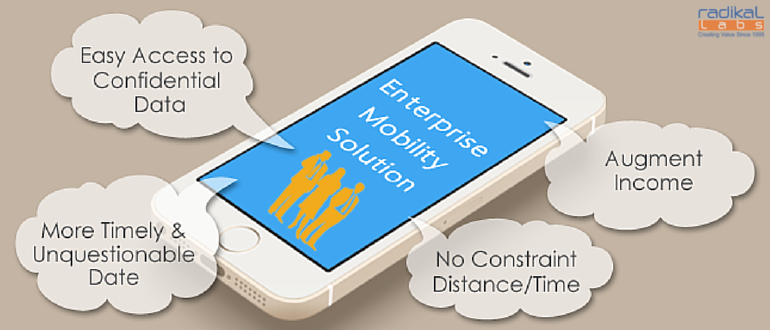Radikally Different - Our World View

Enterprise Mobility Solutions for HR
Mobile connectivity connects 6 billion people in the present times. This is possibly a huge advantage for empowering clients, business owners and employees. Power of connectivity has ensured an overall expansion of enterprise mobility. An engaged workforce most definitely brings in satisfaction and higher retention. Employees are increasingly carrying out important business tasks on their mobile devices. This has made HR (human resource) personnel to make work lives easier by getting introduced to enterprise mobility, thus improving employee motivation and a complete boost to the overall workplace engagement.
While discussing enterprise mobility, we come across our very first question, does the HR department require an app to channelize its workplace demands? The answer lies in the following list of HR demands for mobility:
- Carrying out HR workflow that includes approval for travel and leaves.
- Empowerment of Employees through connectivity.
- Increased productivity due to shared information and critical decisions.
- Managing employee information such as departments, recruitment, timesheets, appraisals, projects handled by individuals and teams.
- Assessing, Planning and Handling internal communication.
- Managing and looking after learning and development cycle in employee engagement.

Enabling Employees to stay connected
It requires optimization of business operations to bring in growth. Organizations must leverage mobility to introduce employee enablement. Employees must be an integral part of business operations. To make them more efficient they must be able to access internal business applications. Employees travelling for business purposes or freelancers working from home must stay accessible and completely aligned with business operations of the organization. Mobility in a workplace includes mobile access in document sharing platforms, business newsletters, corporate alerts, SharePoint, instant messengers, corporate forms, social communication tools, employee directories, emails, timesheets and training materials. Easy to use mobile apps can be introduced for faster adoption even by new employees.
BYOD (bring your own device) can also be taken up. This will be a smart approach towards employee enablement. Security concerns for devices and accessibility issues can be handled by using advanced security policies and encryption methods. Shortened task cycles will gradually improve workplace productivity. Costs will be reduced and information will be centralized. Enhanced communication and collaboration will be ensured within the organization.
Easy access to information will enable heightened organizational development. If you are a first timer (implementing enterprise mobility for the first time in your professional world) then you must take note of the following points:
- Communicate and involve local and global IT support organizations to get a first hand clear idea on the technical process (dos and don’ts of implementing mobility).
- An app must be chosen on the basis of its scalability support. Additional requirements (extended support) must be met by the app.
- Clearances from IT security organizations must be obtained prior hand in order to meet desired deadlines and goals.
- Delays (due to lengthy processes in connecting with internal systems such as HRMS and Active Directory) must be anticipated. Alternate plans must be present.
Given below are a few benefits to HR functions provided by Enterprise mobility:
Improvement in Business Processes
Enterprise mobility involves employees to engage in faster marketing, operations and sales functions. This establishes better engagement with customers. With powerful mobility introduced in a workplace a company’s workforce has access to real-time data which effectively boosts their individual tasks.
Employee engagement
Engaged workplaces make way for higher satisfaction and retention rates. Enterprise mobility induces easier engagement of workforces.
Increased Employee Efficiency
A mobile app makes it easier for an employee to manage his/her daily chores, approvals, mails, task lists and make easy reports. HR professionals can look forward to use an app in planning for employee retention, recruitment, performance appraisals, manpower, resources and administrative functions.
Key HR functions within an organization will be greatly sorted with mobile apps. Convenience brought about by mobility will lead to growth of an organizational structure.
A globalised Workplace with Global Talent Resourcing
For multinational work environments wider challenges are put forward to the HR. Shifting market trends and rapid changes in business strategies lead to changes within the HR. With the advent of enterprise mobility HR roles become business driven. Following HR functions (more business driven) are a part of global mobility oriented programmes:
- Encouraging specialized job roles and careers
- Building more agile workplace structures with well-formed, flat and transparent talent strategies.
- Better training for HR to enhance skills and opportunities.
- Encouraging global mindsets.
- Implementing global leadership strategies.
- Continuous development along with transparent global talent mobility.
- Use analytics to the maximum benefit of understanding global talent issues.
- Integrating better approaches, practices and policies to meet global standards.
- Investment in HR oriented technologies.
Organizations implementing global mobility programs that include the points stated above revolutionize HR functions. Aligning global mobility to talent and business strategies (which form the superstructure for HR functions) require the following steps:
- Increase the use of mobility data analytics.
- Agreeing upon strategic purposes of global mobility.
- Deep understanding of global; deployments and their value propositions.
Enabling HR professionals with suitable skills and providing them with enhanced training in mobility concepts will help them to engage in business driven mobility conversations. This will bridge the gaps in mobility of a business organization and allow them to focus on expanded business objectives and initiatives.
- Augmented Reality (4)
- Enterprise (9)
- Games (15)
- Marketing (17)
- Mobile App Development (26)
- Mobile Apps (19)
- Mobility Solutions (1)
- Monetization (8)
- News (16)
- Remote Hiring (1)
- Strategy (13)
- Testing (7)
- Uncategorized (1)
- User Experience (8)
- Virtual Reality (4)
- Web Browsing (1)
- Web Design & Development (20)